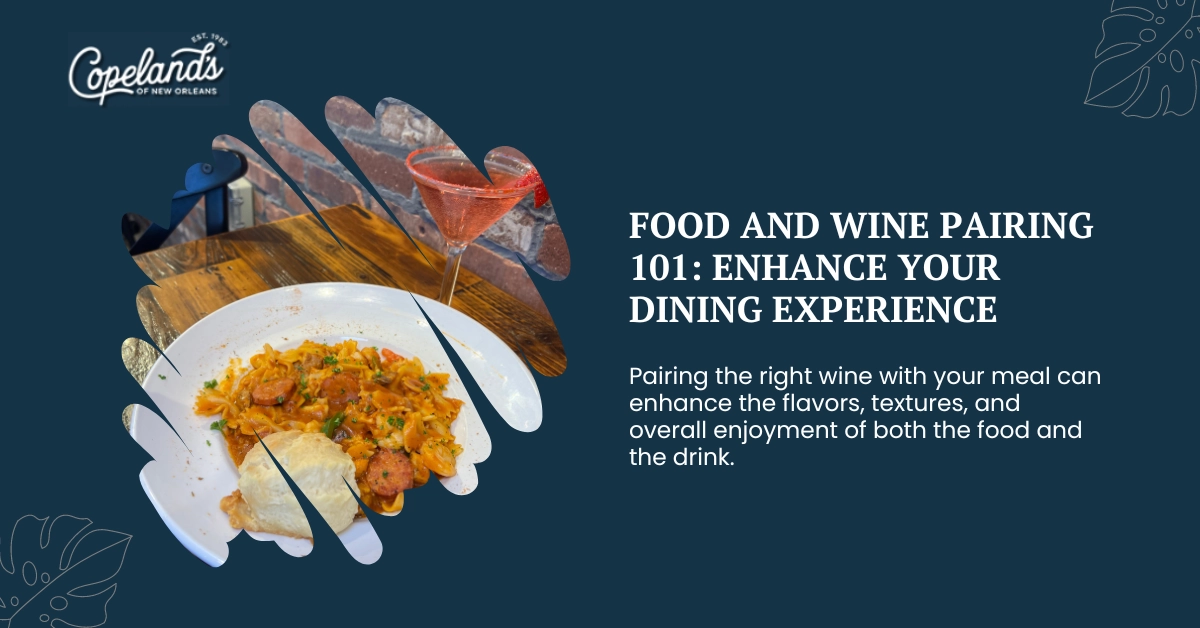There’s something magical about the perfect marriage of food and wine. When the flavors of a dish and a glass of wine complement each other, it can elevate your dining experience to new heights. Whether you’re a seasoned connoisseur or just starting to explore the world of wine, understanding the art of food and wine pairing can help you create unforgettable moments at the table.
Pairing the right wine with your meal can enhance the flavors, textures, and overall enjoyment of both the food and the drink. It’s all about finding the right balance, where each element enhances and brings out the best in the other. But, with so many wine varieties and endless food options, how do you know which pairings will create that perfect harmony on your palate?
Why Opt for the Best Food and Wine Pairing
Have you ever taken a sip of wine after a bite of food and noticed that the flavors clashed, leaving a less-than-pleasant taste in your mouth? We’ve all been there, and it’s precisely why food and wine pairing matters.
When you pair the right wine with your dish, it can enhance the flavors of both the food and the wine, creating a beautiful taste synergy. The wine can bring out the subtle nuances in the dish like a squeeze of lemon brightening up a seafood dish. On the other hand, the food can also complement the wine, making it taste even more delicious and complex.
However, when you have a mismatched pairing, it can throw off the balance and result in one overpowering the other. For example, a bold, tannic red wine can clash with delicate, light seafood, leaving a metallic taste in your mouth. Similarly, a rich, buttery Chardonnay can overwhelm a delicate white fish, drowning out its flavors.
The goal of food and wine pairing is to create a harmonious balance where the flavors of both the food and the wine shine, enhancing each other and creating a memorable dining experience.
The Basics of Food and Wine Pairing
Expanding on the guidelines for food and wine pairing, we delve into the art and science of creating the perfect harmony between culinary delights and the world of wines.
This wine pairing 101 guide will take you through the essentials of pairing food and wine, ensuring each sip and bite is a journey in itself.
1. Understand the Wine’s Characteristics
The first rule in pairing food and wine is to understand the characteristics of the wine you’re serving. These include:
- Acidity – Choose wines with higher acidity, like Sauvignon Blanc for acidic dishes, and low acidity wines, like Chardonnay for creamy and buttery foods.
- Body – Light-bodied wines like Pinot Noir suit delicate dishes, while full-bodied wines like Cabernet Sauvignon enhance richer foods.
- Tannins – High-tannin wines, such as Cabernet Sauvignon, pair well with fatty meats, balancing the dry taste with rich flavors.
- Alcohol Level – Pair sweeter dishes with higher alcohol content wines and spicy foods with lighter, low-alcohol wines like Riesling.
- Flavor Profile – Match the wine’s dominant flavors, whether fruity, earthy, floral, or oaky, with complementary or contrasting dishes.
2. Match the Intensity of Wine and Dish
One of the first things to consider when pairing food and wine is the intensity and weight of both the food and the wine. In simple terms, you want the weight of the wine to match the weight of the dish. This means pairing lighter wines with lighter dishes and heavier wines with richer, more substantial dishes.
Here are examples of wine pairing 101: for example, a delicate white wine, such as a Riesling or Sauvignon Blanc, would pair well with light, delicate dishes like salads, seafood, and fresh vegetables. On the other hand, a full-bodied red wine, such as a Cabernet Sauvignon or Syrah, would be a good match for heavier dishes like steak, lamb, and dishes with rich sauces.
The intensity of the flavors in both the food and the wine should also be taken into account. If you have a strongly flavored dish, it’s best to pair it with a wine that can stand up to and complement those flavors.
A spicy red Zinfandel, for example, can pair well with bold, flavorful dishes. Simultaneously, a crisp, acidic white wine like Chardonnay can cut through the richness of creamy or buttery dishes.
3. Contrast or Similarity in Pairing
To start your wine pairing 101 adventure, you can look into contrast and similarity pairing. It begins with contrast pairing, which involves pairing flavors of wine with the dishes. Here are some contrast-focused wine pairing ideas:
Contrast Pairing
- Red wine with white meat – Lighter-bodied red wines, such as Pinot Noir, can create a lovely contrast when served with white meat, like chicken or turkey.
- Crisp white wine with rich, creamy dishes – The zesty acidity of a crisp white wine, like Chardonnay or Sauvignon Blanc, can cut through the richness of creamy dishes, such as pasta Alfredo or buttery lobster.
- Sparkling wine with salty foods – The effervescence in sparkling wines can refresh your palate when enjoyed with salty foods, like oysters or potato chips.
Similarity Pairing
On the other hand, similarity pairing involves matching wines and dishes with similar flavor profiles. Some classic wine pairing ideas include:
- Rich, red wine with red meat – Cabernet Sauvignon and other full-bodied red wines pair seamlessly with red meat, like juicy steaks or lamb, as the wine’s tannins and the meat’s protein create a delectable flavor combination.
- Sweet wine with dessert – Sweet wines, such as late-harvest Riesling or Port, make for a delightful pairing when served with desserts, as they echo the sweetness in the dish.
- Earthy wine with mushroom dishes – Earthy red wines, like Pinot Noir or Chianti, can bring out the savory flavors in mushroom-based dishes.
4. Regional Pairings
Exploring regional pairings is like taking a culinary journey. Many traditional dishes have evolved alongside the local wines, creating some classic food and wine pairings.
For instance, Italian cuisine, known for its rich tomato sauces and bold flavors, often pairs well with Italian red wines like Chianti or Sangiovese. The acidity in the wines complements the tomatoes, while the bold flavors hold their own against the robust sauces.
Diving further into this wine pairing 101 guide will take us to France. French cuisine, famous for its diverse range of dishes, can be paired with different wines depending on the region. For example, dishes from the Burgundy region, like coq au vin, which is chicken braised in red wine, are a natural match for the local red wines made from Pinot Noir grapes.
When serving spicy dishes like Indian or Mexican cuisine, off-dry or semi-sweet white wines can help balance the heat, as their slight sweetness can cool the palate.
For Asian dishes, such as sushi or Thai curry, wine pairing ideas include pairing them with a crisp, aromatic white wine, like Riesling or Gewürztraminer, to complement the vibrant flavors.
Wine Pairing 101: Choose the Right Wine for Your Meal
Choosing the right wine for your meal can be a daunting task, but it doesn’t have to be. Here are some tips to help you navigate the world of wine and food pairings:
1. Consider the Wine Menu
If you’re dining out, take a look at the wine menu and see if they have any suggested pairings for the dishes you’re interested in. Many restaurants put heavy thought into their wine selections and can offer wine pairing ideas and recommendations to enhance your dining experience.
2. Match the Wine to the Sauce
The basics of wine pairing 101 involve choosing a wine that complements your sauces. When pairing wine with dishes that have a sauce, consider the characteristics of the sauce. If it’s rich and creamy, buttery Chardonnay can be a good match. For dishes with tangy or citrus-based sauces, try a wine with higher acidity to balance the flavors.
3. Take Note of the Wine’s Sweetness
Consider the sweetness of the wine when pairing with spicy dishes. In general, off-dry or slightly sweet wines can help tame the heat. However, for dishes with a touch of sweetness, like barbecue, you can opt for a wine with a hint of sweetness to complement the flavors.
4. Think About Wine Temperature
Take note of the wine’s recommended serving temperature. It’s a good idea to pair lighter, more refreshing wines with warmer dishes and save full-bodied, richer wines for cooler-temperature dishes.
5. Pair Red Wine with Red Meat and White Wine With White Meat
One of the most well-known principles in pairing food and wine is to match red wine with red meat and white wine with white meat. The tannins in red wine can interact with the protein in meat, enhancing the flavors and creating a pleasant taste sensation. On the other hand, white wine can complement the lighter flavors and textures of poultry and fish.
6. Don’t Forget Rosé and Sparkling Wines
Rosé and sparkling wines are incredibly versatile when it comes to wine and food pairings. Their vibrant acidity and effervescence can complement a wide range of dishes, including salads, seafood, and even some light meats. If you’re unsure about which wine to choose, a quality rosé or sparkling wine can be a safe and stylish option.
7. Trust Your Palate
Ultimately, the most important factor in successful pairing food and wine is your palate. Everyone has different tastes and preferences, so don’t be afraid to experiment and trust your instincts. If you have a favorite wine that you love, don’t hesitate to enjoy it with your meal, regardless of traditional pairing rules. The goal is to create a dining experience that brings you joy and satisfaction.
Common Wine and Food Pairing Mistakes to Avoid
Now that you have a good grasp of the principles of food and wine pairing, let’s talk about some common pitfalls to dodge. Learning from these mistakes will save you from potential flavor clashes and ensure a more enjoyable dining experience.
1. Treating rules as gospel
While it’s essential to understand the principles of food and wine pairing, it’s equally important not to treat them as hard and fast rules. Every palate is unique, and what works for one person may not work for another. So, feel free to occasionally break the rules of conventional wine pairing 101 guides and forge your path to flavor harmony.
Don’t let the rules hold you back. They are more like guidelines, and sometimes, the most memorable pairings come from thinking outside the box and taking risks.
2. Overlooking Personal Preferences
One of the biggest mistakes you can make in wine and food pairing is to overlook your personal preferences. No matter how well a pairing is supposed to work, if you don’t enjoy the wine or the dish, it’s not a successful match for you.
The ultimate judge of good wine and food pairings is your palate. It’s the one that matters most, so trust your taste buds and go for what you love.
3. Pairing With the Dominant Ingredient
Another pitfall to avoid is solely focusing on the dominant ingredient in a dish when selecting a wine. While it’s essential to consider the main flavor, pairing food and wine is a more nuanced game. Take into account the preparation method and the supporting ingredients, as they can significantly impact the overall taste.
Remember, in a dish, every ingredient has a role to play, and the supporting cast can sometimes steal the show when it comes to wine and food pairing.
4. Using the Same Approach for All Wines
Here’s something to remember for your wine pairing 101: not all wines are created equal, and this leads us to our next mistake: using the same approach for all wines. Each variety has its personality and characteristics, so it’s essential to consider these factors when making wine pairing ideas.
Give each wine the attention it deserves. They have unique qualities and, like chameleons, can adapt to different dishes in their special way.
5. Neglecting the Order of Service
The order of service is often a neglected aspect of wine and food pairings, but it can significantly impact your dining experience. Lighter wines are best enjoyed before their heavier counterparts. Starting with a bold wine can overpower the palate, making it difficult to appreciate the more delicate flavors that follow.
Remember the order. It’s like a carefully choreographed dance, ensuring that each wine and dish gets its moment to shine.
Food and Wine Pairing Ideas
Now that you have a good grasp of the basic principles of food and wine pairing, let’s explore some wine pairing ideas to inspire your next culinary adventure:
1. Crisp, Dry White Wine With Seafood
Seafood, with its delicate flavors, often sings when paired with a crisp, dry white wine. The wine’s acidity can cut through the richness of the seafood, enhancing its freshness. Sauvignon Blanc is a classic choice, but if you prefer a lighter-bodied wine, try a dry Riesling or a refreshing Pinot Grigio.
2. Red Wine With Grilled or Roasted Meats
The bold flavors of grilled or roasted meats are a natural fit for red wine. The charred, smoky notes in the meat can complement the fruitiness and complexity of the red wine, creating a mouthwatering combination. For juicy burgers or grilled sausages, try a Zinfandel or a Syrah. For roasted lamb or beef, a Cabernet Sauvignon or a Merlot can be an excellent choice.
3. Champagne or Sparkling Wine With Fried Chicken
There’s something undeniably decadent about the contrast of crispy fried chicken and the effervescence of Champagne or sparkling wine. The bubbles help cleanse the palate, making every bite of chicken as delicious as the first. For a classic touch, go for Champagne, but if you prefer a more budget-friendly option, try a dry Prosecco.
The Bottom Line
In the art of food and wine pairing, understanding the interplay between the flavors of your meal and the characteristics of your wine is crucial. This wine pairing 101 guide emphasizes the importance of matching the intensity of your wine with your dish, whether through contrast or similarity, to create a harmonious dining experience.
Traditional regional pairings offer a time-tested guide. However, experimenting with different wine and food pairings based on personal preferences can lead to delightful discoveries. Remember, the key to successful pairing food and wine lies in balancing the elements and being open to exploring new wine pairing ideas.
Discover the Perfect Pair at Copeland’s of New Orleans!
Indulge in the rich flavors of New Orleans cuisine perfectly complemented by Copeland’s wine choices. Visit us at Copeland’s of New Orleans and let our expert team guide you through an exquisite journey of wine and food pairings. Contact us to book a reservation and experience the harmony of taste with our carefully curated wine selection.





